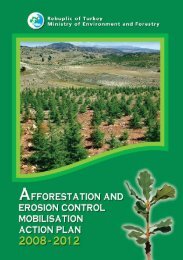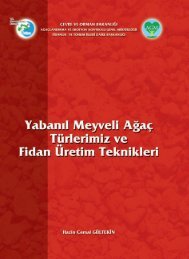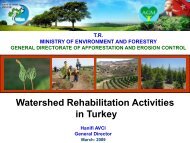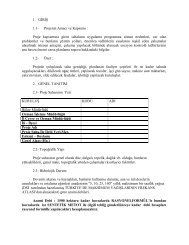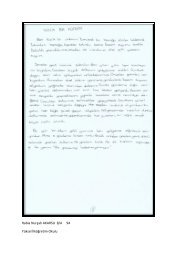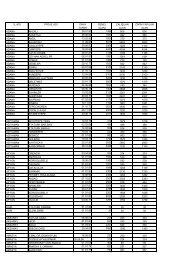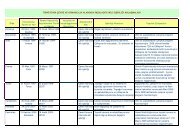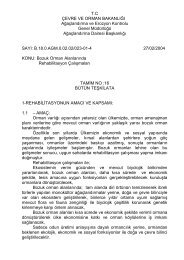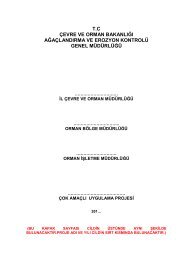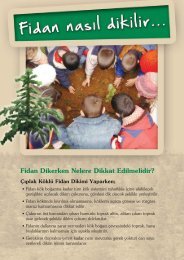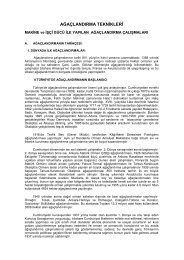republic of turkey ministry of environment and forestry directorate
republic of turkey ministry of environment and forestry directorate
republic of turkey ministry of environment and forestry directorate
You also want an ePaper? Increase the reach of your titles
YUMPU automatically turns print PDFs into web optimized ePapers that Google loves.
REPUBLIC OF TURKEYMINISTRY OF ENVIRONMENT AND FORESTRYDIRECTORATE GENERAL OF AFFORESTATION AND EROSION CONTROL
ResultAdvantages that rehabilitation <strong>of</strong> naturalresources <strong>and</strong> increasing rural povertyactivities bring;• Conservation <strong>of</strong> current forests <strong>and</strong> rangel<strong>and</strong>s,• Rehabilitation <strong>and</strong> development <strong>of</strong> degraded forests<strong>and</strong> rangel<strong>and</strong>s,• Prevention <strong>of</strong> erosion, flood <strong>and</strong> overflows,• Strengthening <strong>and</strong> diversifying agricultural systems,• Creating additional employment opportunities<strong>and</strong> decreasing poverty,• Strengthening organisational capacity.Advantages that decreasing <strong>and</strong> monitoringagricultural <strong>and</strong> animal related water pollutionactivities bring;• Increase in the quality <strong>of</strong> surface <strong>and</strong>underground waters,• Decrease in nutrient discharge to major rivers<strong>and</strong> Black Sea,• Compliance with <strong>environment</strong>al regulationswith regard to water discharges,• Compliance with EU regulations <strong>and</strong> good agriculturalpractices with regard to Nitrate monitoring,• Creating additional employment opportunities<strong>and</strong> decreasing poverty,• Strengthening organisational capacity.
Most important reasons for natural resource destruction at the upper watersheds are rapid population growth,insufficiency <strong>of</strong> farming resources, rural poverty <strong>and</strong> as a result <strong>of</strong> these factors over-grazing, heating <strong>and</strong>gaining farml<strong>and</strong> activities.First watershed based works in Turkey were introduced with the aim <strong>of</strong> decreasing the damages <strong>of</strong> floods <strong>and</strong>overflows <strong>and</strong> thereby providing safety for current dams through erosion <strong>and</strong> afforestation projects. Theseprimary implementations at the upper watersheds were realised as decreasing soil erosion, facilities regulatingthe water regime <strong>and</strong> afforestations. In the meanwhile, various supports were provided to the watershed localcommunities by conservation <strong>of</strong> natural vegetation cover <strong>and</strong> regulating grazing at rangel<strong>and</strong>s. Preventions forincreasing isolation in the houses were developed in order to decrease wood consumption.In Eastern Anatolia Watershed Rehabilitation Project, which was a first generation watershedrehabilitation financed by World Bank, integrated participatory approach was embraced <strong>and</strong> a projectapproach was implemented in which all related government agencies cooperated with the local people. All theactivities within the project were aimed at upper parts <strong>of</strong> the catchment.Natural resource conservation <strong>and</strong> rehabilitation was targeted <strong>and</strong> in order to reach this target, income raisingactivities to increase the living st<strong>and</strong>ard <strong>of</strong> local community as well as training the local people for naturalresource preservation <strong>and</strong> sustainable management activities were realised. Local people were trained whilethe capacity building activities for the agencies were also continued.In Anatolia Watershed Rehabilitation Project, which is a second generation watershed rehabilitation,the overall watershed was taken into consideration <strong>and</strong> in the selected micro-catchments integration <strong>of</strong>preservation <strong>and</strong> rehabilitation <strong>of</strong> natural resources with income raising activities are aimed at. Training <strong>of</strong> localpeople as well as capacity building <strong>of</strong> related agencies are targeted. In sustainable watershed management,decreasing the pollution in surface <strong>and</strong> underground waters deriving from animal related activities <strong>and</strong> manure<strong>and</strong> pesticide used in agricultural activities; thereby decreasing the drainage <strong>of</strong> nutrients into seas are aimedat. Monitoring water pollution, supporting organic farming activities, spreading these activities all around thecountry <strong>and</strong> providing support in implementation <strong>of</strong> EU Nitrate Directive are also targeted.Çoruh River Rehabilitation Project is similar to the previous projects in a different part <strong>of</strong> the countrywith different characteristics; apart from the abovementioned activities, extending <strong>and</strong> supporting the solarenergy system, which is a renewable energy source, was targeted in order to reduce consumption <strong>of</strong> fossil fuel.In the third generation Watershed Rehabilitation Projects that are in the making, integrated watermanagement is included within the projects since the need for water resources increases along withconservation <strong>and</strong> improvement <strong>of</strong> natural resources. The following subjects are featured: prevention <strong>of</strong>pollution deriving from industrial <strong>and</strong> domestic wastes, water production, management <strong>and</strong> operation <strong>of</strong> upperwatershed forests in line with water production, planning product range according to current water bodies, etc.The Experience <strong>and</strong> Development obtained in the Watershed Rehabilitation Projects that are implementedin Turkey, appear as a model to be used in similar watersheds.1
WatershedA watershed is a plot <strong>of</strong> l<strong>and</strong> that is dividedby a stream <strong>and</strong> has idiosyncratic naturalresources. A watershed starts where the wateris discharged into seas or lakes, proceedsto the peak <strong>and</strong> is divided into severalmicro-catchments.WatershedManagementIs planning, developing <strong>and</strong> management <strong>of</strong>sustainable use <strong>of</strong> natural resources in a waythat social, cultural <strong>and</strong> economic development<strong>of</strong> the community will be provided by consideringmain principals <strong>of</strong> ecology in a watershed.Main elements <strong>of</strong> watershedmanagement are Soil,Human <strong>and</strong> Management.WatershedRehabilitationWatershed rehabilitation covers all the activitiesrealised in order to provide social, cultural <strong>and</strong>economic development <strong>of</strong> the local communityin the watershed by taking technical, cultural <strong>and</strong>administrative precautions to set natural balanceamong soil, water <strong>and</strong> vegetation in a Watershed.3
WatershedManagement WorksWatershed management works werefirst started in Europe <strong>and</strong> then reachedto America later. In France, the aim <strong>of</strong>these works is flood control, whereasAmerica aims to provide continuous,safe water <strong>of</strong> good quality. Because thedensity <strong>of</strong> the community living in highermountainous catchments is generally low.These sites are covered with extremelywide forests <strong>and</strong> rangel<strong>and</strong>s. Unlike theabovementioned developed countries,in developing countries like our countryhigher catchments have high populationdensity. Therefore, the objectivesin watershed management may differin many ways.In all countries, at the beginning,watershed rehabilitation was firstlyimplemented for immobilising the soil,developing the forests <strong>and</strong> constructinginfrastructure facilities such as ponds.Today, improvement <strong>of</strong> local community’slife st<strong>and</strong>ards <strong>and</strong> sustainability areincluded among watershed rehabilitationobjectives.4
Policies <strong>of</strong> WatershedRehabilitation ProjectsGlobal warming <strong>and</strong> climate changes are the most significant problems, today, that st<strong>and</strong>before the humanity. Combating against desertification <strong>and</strong> drought is a common responsibilityfor all the countries in the world. The problems, deriving from global warming <strong>and</strong> climatechange as a result <strong>of</strong> the increase in the greenhouse gases, are accelerating day by day.The most significant problem that the world mustdeal with today is to build up a system whichwould provide a sustainable natural resourcemanagement meeting basic needs <strong>of</strong> humans. Animportant way <strong>of</strong> providing these is preparation <strong>and</strong>implementation <strong>of</strong> participatory <strong>and</strong> IntegratedWatershed Rehabilitation Projects on watershedbasis which include ecologic, social, cultural <strong>and</strong>economic aspects by common efforts <strong>of</strong> all sectors.In order to decrease the pressure <strong>of</strong> localcommunity on natural resources <strong>of</strong> the watershed,local community’s opinion should be taken in alltypes <strong>of</strong> activities <strong>and</strong> the activities should besupported by income raising activities which wouldincrease the life st<strong>and</strong>ard.The most significantproblem that the world mustdeal with today is to build upa system which would providea sustainable natural resourcemanagement meeting basicneeds <strong>of</strong> humans.Policies <strong>of</strong> WatershedRehabilitation Projects• Conservation, Rehabilitation <strong>and</strong> Management<strong>of</strong> Natural Resources,• Conservation <strong>of</strong> Natural Resources throughIncome Raising Activities, Rehabilitation<strong>and</strong> Management Activities Integration• Developing Human Resources• Sustainability <strong>and</strong> Generalisation5
The method <strong>of</strong> approach that prioritisespublic participation in the decisions relatedto local implementations constitutes the maintheme in this type <strong>of</strong> projects.6
Approach in WatershedRehabilitationIt is considered that water management starts from upper watersheds; that functional <strong>forestry</strong>works in these catchments constituting the water bodies have a key role; that degradationsin the upper catchments directly affect the water management in the lower catchments <strong>and</strong>the ones that use the water bodies in these catchments; <strong>and</strong> that it is obligatory to approachwatershed management in an integrated way.With the activities towards conservation <strong>of</strong> upper watersheds, <strong>and</strong> afforestation <strong>and</strong> plantationactivities; protection from direct rain contact <strong>and</strong> so prevention <strong>of</strong> surface flows, erosion, floods<strong>and</strong> overflows as well as feeding underground waters are aimed at. All these preventions areto provide a healthy <strong>and</strong> natural water cycle in a sustainable way.Rural poverty is an important elementfor pressure on the natural resources<strong>of</strong> upper watersheds <strong>and</strong> it constitutesan important problem leading to the disorder<strong>of</strong> the natural balance in these watersheds.Therefore, attempts are made for integration<strong>of</strong> preventions for watershed rehabilitation<strong>and</strong> conservation with preventions forincreasing rural poverty.Water protection can be realisedthrough soil conservation.It is considered that a part <strong>of</strong> the incomescollected directly or indirectly as a result<strong>of</strong> using water bodies should be sparedfor financing the preventive activitiesto be realised at the upper watersheds.7
Challenges inthe Watersheds• Soil erosion• Natural resource degradation• Over- <strong>and</strong> irregular grazing at therangel<strong>and</strong>s• Poor vegetation• Over- <strong>and</strong> irregular use <strong>of</strong> forestl<strong>and</strong>s• Nomadic animal husb<strong>and</strong>ry• Dispersed settlement• Decrease in human resources(Insufficient manpower due tomigration)• Decrease in animal productivity• Misuse <strong>of</strong> farml<strong>and</strong>s• Insufficient water bodies• Lack <strong>of</strong> modern agriculturetechniques• Insufficient organic substanceat farml<strong>and</strong>s• Rural poverty• Lack <strong>of</strong> training for correct use<strong>of</strong> natural resources• Destruction due to industry <strong>and</strong>polluted natural resources• Incomplete l<strong>and</strong> cadastre8
Results <strong>of</strong> L<strong>and</strong>Degradation at the Watersheds• Increase in erosion• Increase in salinization <strong>of</strong> soil• Decrease in farm products(Quantity + Quality)• Increase in insects <strong>and</strong> diseases(Plant + Farming)• Decrease in fodder crop at the rangel<strong>and</strong>s• Decrease in biological diversity• Decrease in water yield• Increase in forest fires• Plant extinction• Decrease in water bodies• Increase in water dem<strong>and</strong>• Increase in natural resource degradation• Increase in floods <strong>and</strong> overflows• Poverty <strong>and</strong> migration9
Watershed Rehabilitation ProjectsBy coordination <strong>of</strong> Directorate General <strong>of</strong> Afforestation <strong>and</strong> Erosion ControlEASTERN ANATOLIA WATERSHED REHABILITATION PROJECTANATOLIA WATERSHED REHABILITATION PROJECTÇORUH RIVER WATERSHED REHABILITATION PROJECT10
Eastern Anatolia WatershedRehabilitation ProjectThe project h<strong>and</strong>led with rural poverty <strong>and</strong> natural resource degradation problems in upper Euphrates <strong>and</strong>Tigris River catchments, was carried out by World Bank loan support, aimed at sustainable <strong>and</strong> improvedrangel<strong>and</strong>, <strong>forestry</strong> <strong>and</strong> agricultural activities at the micro catchments by decreasing soil erosion <strong>and</strong>increasing soil fertility.• The project was started in 1993 at Elaz›¤, Malatya<strong>and</strong> Ad›yaman provinces, continued in 1998 atAdana, K.Marafl <strong>and</strong> Sivas <strong>and</strong> in 1999 at Isparta,Antalya, Mersin, Gaziantep <strong>and</strong> fianl›urfa provinces;in total the project was implemented in85 micro-catchments at 11 provinces <strong>and</strong> wascompleted as <strong>of</strong> 30 September 2001. At the end<strong>of</strong> nine year project implementation, all agenciesspent US$78,333,000 in total.• In the project, participation <strong>of</strong> local communityis aimed at as well as decreasing erosion inrangel<strong>and</strong>s <strong>and</strong> forestl<strong>and</strong>s,• Increasing fire wood <strong>and</strong> fodder plant production,• Enabling sustainable use <strong>of</strong> marginal farml<strong>and</strong>s,• Supporting income generating activities whichwould result in a short term so that localcommunity would embrace the implementationsat the rangel<strong>and</strong>s <strong>and</strong> forestl<strong>and</strong>s,• Increasing the responsibility level <strong>of</strong> localcommunity in resource planning <strong>and</strong> management<strong>and</strong> enabling their participation are also aimed at.COLLABORATING AGENCIES WITHINTHE INTEGRATED PROJECT• Directorate General <strong>of</strong> Afforestation <strong>and</strong>Erosion Control (as Coordinator)• Directorate General <strong>of</strong> Forest Village Relations• Directorate General <strong>of</strong> Forestry• Directorate General <strong>of</strong> Rural Affairs• Directorate General <strong>of</strong> Agricultural Production<strong>and</strong> Development11
Realised Works• 73.156 ha. Soil Conservation Afforestation,• 19,882 Ha. Rangel<strong>and</strong> Rehabilitation,• 2240 Ha. Oak,1687 Ha. Cedar Rehabilitation, workswere realised <strong>and</strong> for all these works from thebeginning until the end <strong>of</strong> 2001, US$ 27,039,000foreign loan was used <strong>and</strong> US$15,998,000 internalexpenditure was made <strong>and</strong> totally US$ 43,027,000was spent.12
• Within the Project, TÜGEM realised the following works: 7,888 ha Agronomic Packageimplementation, 9,813 ha. Mitigation <strong>of</strong> Fallowing L<strong>and</strong>, 1588 ha. Demonstration Work, 1,224,000Pistachio Grafting, 238,049 Field Boundary Seedling Plantation, 1,903 ha. Irrigated FodderProduction, 8,864 ha. Fruit Orchard Establishment <strong>and</strong> 34,560 Beehives distribution. Totally,US$ 6,047,000 was spent for all these works.• As a result <strong>of</strong> project implementations,KHGM spent US$29,258,000 in total.• 1,069,498 m irrigation channel,• 1.260 irrigation ponds,• Small water bodies were used,• 2,643 ha agricultural terrace construction wasrealised <strong>and</strong> 12,368 ha area was openedto irrigation.13
Anatolia WatershedRehabilitation ProjectThe Project was put into force following the agreement signed by Turkish Republic <strong>and</strong> World Bankon October 4 th , 2004 <strong>and</strong> the coordinator unit <strong>of</strong> the project is Directorate General <strong>of</strong> Afforestation<strong>and</strong> Erosion Control.Anatolia Watershed Rehabilitation Project covers natural resource rehabilitation <strong>and</strong> decreasing ruralpoverty activities in 28 upper micro-catchments located in Amasya, Çorum, Samsun, Tokat, Sivas <strong>and</strong>Kayseri provinces in watersheds <strong>of</strong> K›z›l›rmak <strong>and</strong> Yeflil›rmak rivers; <strong>and</strong> decreasing <strong>and</strong> monitoringagricultural, animal <strong>and</strong> water pollution activities in lower micro-catchments.This project aimsat participation<strong>of</strong> all relatedgovernmentagencies aswell as localcommunity fora sustainablenatural resourcemanagement.15
Project Development ObjectiveThe project’s overall development objective isto support sustainable resource managementpractices in 28 micro-catchments in Anatolia<strong>and</strong> Turkey’s Black Sea Region <strong>and</strong> therebyraise incomes <strong>of</strong> communities affected byresource degradation.Global ObjectiveThe global objective is to introduce farmingpractices which will reduce the discharge <strong>of</strong>agricultural nutrients into surface <strong>and</strong> groundwater in watersheds draining into Black Sea.Project MissionAll communities <strong>and</strong> related groups that areresponsible for natural resource management<strong>and</strong> affected by this management, are involvedin each phase <strong>of</strong> management includingdecision making, planning <strong>and</strong> implementation,monitoring, evaluation <strong>and</strong> assessment.PROJECT BUDGET (Million $)Loan Grant TotalWorld Bank 15.70 7.00 22.70Government 11.49 2.20 13.69Participator 7.71 0.80 8.51Total 34.90 10.00 44.9016
IMPLEMENTING AGENCIES AT THE CENTRAL LEVELMinistryMinistry <strong>of</strong> Environment <strong>and</strong> Forestry (MoEF)General Directorates• Directorate General <strong>of</strong> Afforestation <strong>and</strong> Erosion Control (AGM)• Directorate General <strong>of</strong> Forestry (OGM)• Directorate General <strong>of</strong> Forest Village Relations (ORKÖY)• Directorate General <strong>of</strong> Environment Management (ÇYGM)Ministry <strong>of</strong> Agriculture <strong>and</strong> Rural Affairs (MARA)• Directorate General <strong>of</strong> Agricultural Production <strong>and</strong> Development (TÜGEM)• Directorate General <strong>of</strong> Protection <strong>and</strong> Control (KKGM)IMPLEMENTING AGENCIES AT PROVINCIAL LEVELAgenciesGovernor’s <strong>of</strong>ficeRelated agencies within the projectInternational OrganisationsRelated Departments• Provincial Directorates <strong>of</strong> Environment <strong>and</strong> Forestry (AGM, ORKÖY, ÇYGM)• Regional Directorate <strong>of</strong> Forest <strong>and</strong> Operational Directorates (OGM)• Provincial Directorates <strong>of</strong> Agriculture• Special Provincial Administration Directorates• Municipalities, Mukhtars• NGO’s• Cooperatives <strong>and</strong> Associations• Others• World Bank (WB)• Global Environment Facility (GEF)17
Project ActivitiesI- Rehabilitation <strong>of</strong>Degraded NaturalResources• Rehabilitation <strong>of</strong> forestl<strong>and</strong>s,rangel<strong>and</strong>s <strong>and</strong> farml<strong>and</strong>s.• Environment friendly agriculturalpractices.• Measuring <strong>and</strong> monitoring waterpollution.18
Rehabilitation <strong>of</strong> Degraded Natural ResourcesActivities Unit Project RealisationObjective as <strong>of</strong> 2008Soil Conservation Afforestation Hectare 15.600 13.527Protection <strong>and</strong> Rehabilitation <strong>of</strong> Poor <strong>and</strong> Degraded Soils Hectare 2.265 490Soil Conservation Afforestation Maintenance Hectare 9895Rehabilitation <strong>of</strong> High Forest with 10% Canopy Closure Hectare 807 560Planning <strong>of</strong> Range Management in Forest L<strong>and</strong> Hectare 1.800 950Management <strong>of</strong> Range Rehabilitation in Forest L<strong>and</strong> Hectare 2.350 2.725Range Rehabilitation Activities out <strong>of</strong> Forest L<strong>and</strong> Hectare 2.442 503Oak Coppice Rehabilitation Hectare 2.875 150Participatory Planting Hectare 710 70Construction <strong>of</strong> farm <strong>and</strong> household type manure store facilities Number 800 265Construction <strong>of</strong> central manure store facilities Number 11 6Establishment <strong>of</strong> water monitoring points Point 107 8919
II – Income Raising Activities• Small scaled irrigation.• Agricultural terrace <strong>and</strong> production in these terraces.• Increasing <strong>and</strong> developing product variety in agricultural products.• Developing animal husb<strong>and</strong>ry, greenhouse, fishery <strong>and</strong> beekeeping.Income Raising ActivitiesActivities Unit Planned Realisation (*)Mitigation <strong>of</strong> Fallowing L<strong>and</strong> Hectare 1.834 1.498Correct Use <strong>of</strong> Marginal Agricultural L<strong>and</strong> Hectare 509 604Environment Friendly Farming Techniques Hectare 155 3Irrigated fruit production Hectare 539 149Rainfed fruit production Hectare 751 148Irrigated fodder production Hectare 596 821Vegetable Production Hectare 199 29Trees along field boundaries Hectare 90 57Apiculture Unit 360 69Dairy cow keeping Unit 168 272Dairy sheep keeping Unit 169 42(*) Realisation as <strong>of</strong> 200820
III- Strengthening Policy <strong>and</strong> Regulatory Capacitytowards Meeting EU St<strong>and</strong>ards• Supporting implementation <strong>of</strong> EU Nitrate Directive.• Setting <strong>and</strong> introducing agricultural practice rules.• Corporate support for organic farming.22
IV– Training <strong>and</strong> AwarenessRaising Works• Conservation <strong>of</strong> natural resources,• Increasing productivity in farming,• Training the farmers about inorganic manure <strong>and</strong>pesticide use, <strong>and</strong> organic farming techniques as wellas introduction <strong>of</strong> new techniques to the farmers <strong>and</strong>awareness raising works will be continued duringthe project period.Training <strong>and</strong>awareness raisingworks are focusedon income <strong>of</strong> localcommunity <strong>and</strong>sustainability <strong>of</strong>natural balance.24
Çoruh RiverRehabilitation ProjectPlanned ProjectsÇoruh Watershed is located at northeast <strong>of</strong> Turkey, at the south <strong>of</strong> BlackSea <strong>and</strong> adjacent to neighbouring country Georgia border <strong>and</strong> coversnearly 2 million hectares l<strong>and</strong>. The project is an integrated project <strong>and</strong>Artvin, Bayburt <strong>and</strong> Erzurum provinces are included within the project.There are 18 Micro-catchments within the project, 12 <strong>of</strong> them are <strong>of</strong> highpriority <strong>and</strong> covers 604,301 hectares l<strong>and</strong>, 242 villages <strong>and</strong> 55,000 people.Coordination <strong>of</strong> the Project will be undertaken by Directorate General <strong>of</strong>Afforestation <strong>and</strong> Erosion Control <strong>and</strong> the Project will be financed byTurkish Republic <strong>and</strong> JICA.Participatoryapproach <strong>and</strong>sustainabilityare aimed atthis projectas are otherimplementedwatershedrehabilitationprojects inour country.27
Planned Projects• Subproject A: Conservation,rehabilitation <strong>and</strong> sustainablemanagement <strong>of</strong> natural resource• A.1 Erosion control <strong>and</strong> prevention<strong>of</strong> natural disasters,• A.2 Rehabilitation <strong>and</strong> sustainable management<strong>of</strong> rangel<strong>and</strong>s,• A.3 Natural resource development servingfor multiple MCs,• Subproject B: Livelihoodimprovement <strong>of</strong> villagers• B.1 Small scale irrigation infrastructure improvement,• B.2 Income generating activities,• B.3 Wood consumption saving practice,• B.4 Marketing assistance serving for multiple MCs,• Subproject C: Capacity development• C.1 Natural disasters' prevention,• C.2 Integrated <strong>and</strong> participatory approachon watershed rehabilitation,• C.3 Technical training <strong>of</strong> line agencies' staffs,• C.4 Capacity development <strong>of</strong> local communities,PROJECT AGENCIESMINISTRY OF ENVIRONMENTAND FORESTRY• Directorate General <strong>of</strong> Afforestation<strong>and</strong> Erosion Control• Directorate General <strong>of</strong> Forest VillageRelations• Directorate General <strong>of</strong> NaturalPreservation <strong>and</strong> National Parks• Directorate General <strong>of</strong> ForestMINISTRY OF AGRICULTUREAND RURAL AFFAIRS• Directorate General <strong>of</strong> AgriculturalProduction <strong>and</strong> DevelopmentSPECIAL PROVINCIALADMINISTRATIONS• Artvin, Bayburt ve Erzurum28




